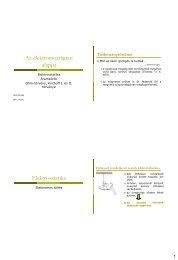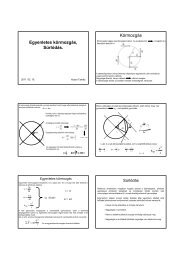The Structure of the Cell Membrane Resting Membrane Potential
The Structure of the Cell Membrane Resting Membrane Potential
The Structure of the Cell Membrane Resting Membrane Potential
Create successful ePaper yourself
Turn your PDF publications into a flip-book with our unique Google optimized e-Paper software.
<strong>The</strong> <strong>Structure</strong> <strong>of</strong> <strong>the</strong> <strong>Cell</strong> <strong>Membrane</strong><br />
<strong>Resting</strong> <strong>Membrane</strong> <strong>Potential</strong><br />
25.09.2012.
Phospholipids<br />
<strong>The</strong> main component <strong>of</strong> <strong>the</strong> biological membranes.<br />
Phospholipid = diglyceride (glycerine+fatty acid) + phosphate<br />
group + organic molecule (e.g. choline).<br />
„water soluble fat”<br />
Polar – head<br />
(hydrophilic)<br />
Non-polar – tail<br />
(hydrophobic)<br />
phosphatidil - cholin
Irving Langmuir<br />
1881 - 1957<br />
American physico-chemist<br />
1932 Nobel-price in chemistry<br />
• 1917 – lipids form a monolayer on <strong>the</strong><br />
surface <strong>of</strong> <strong>the</strong> water<br />
polar heads (hydrophilic) – oriented<br />
toward <strong>the</strong> water<br />
nonpolar tails (hydrophobic) – oriented<br />
away from water<br />
Irving Langmuir, "<strong>The</strong> Constitution and Fundamental Properties <strong>of</strong> Solids and Liquids. II," Journal <strong>of</strong> <strong>the</strong> American Chemical Society 39 (1917): 1848-1906.<br />
water
Lipid bilayer<br />
1925 – Evert Gorter & F. Grendel (University <strong>of</strong> Leiden, Holland)<br />
• compared <strong>the</strong> surface area <strong>of</strong> <strong>the</strong> erythrocytes and <strong>the</strong> surface<br />
area calculated from <strong>the</strong> lipid content <strong>of</strong> <strong>the</strong>m.<br />
• Gorter E, Grendel F. On Bimolecular Layers <strong>of</strong> Lipoids on <strong>the</strong><br />
Chromocytes <strong>of</strong> <strong>the</strong> Blood. J Exp Med. 1925 Mar 31;41(4):439-43.<br />
Gortel, E. & Grendel, F. (1925) On bimolecular layers <strong>of</strong> lipoid on <strong>the</strong> chromocytes <strong>of</strong> <strong>the</strong> blood. J. Exp. Med. 41, 439–443.
Lipid bilayer<br />
• twice as much lipid in <strong>the</strong> membrane <strong>of</strong> <strong>the</strong> red blood cells than<br />
needed for a monolayer → lipid bilayer<br />
Polar heads toward <strong>the</strong><br />
intra- and extracellular<br />
space<br />
EC<br />
IC<br />
Gortel, E. & Grendel, F. (1925) On bimolecular layers <strong>of</strong> lipoid on <strong>the</strong> chromocytes <strong>of</strong> <strong>the</strong> blood. J. Exp. Med. 41, 439–443.<br />
Apolar tails in <strong>the</strong><br />
middle
• phospho-lipid bilayer<br />
„Fluid mosaic” model<br />
• 1972 - Singer and Nicholson „fluid mosaic” model<br />
• Fluid – lateral movement <strong>of</strong> <strong>the</strong><br />
components („floating”)<br />
• Mosaic – <strong>the</strong> mosaic-like<br />
arrangement <strong>of</strong> <strong>the</strong><br />
macromolecules<br />
http://www.molecularexpressions.com/cells/plasmamembrane/plasmamembrane.html<br />
Singer SJ, Nicolson GL. <strong>The</strong> fluid mosaic model <strong>of</strong> <strong>the</strong> structure <strong>of</strong> cell membranes. Science. 1972 Feb 18;175(23):720-31.
<strong>Structure</strong> <strong>of</strong> <strong>the</strong> cell membrane<br />
Flip-flop<br />
rotation<br />
Lateral diffusion<br />
Phospholipide molecule (~40-60%)<br />
Polar<br />
(hydrophilic) head<br />
Non-polar<br />
(hydrophobic) tail<br />
Protein molecule (~30-50%)<br />
~ 5 nm
Functions <strong>of</strong> <strong>the</strong> membrane poteins<br />
• Ion channels (Na + /K + ATPase)<br />
• Transporters (Aquaporin-H 2O transport)<br />
• Structural elements<br />
• Intracellular connections (anchoring – cytoskeleton)<br />
• Extracellular connection (gap junction: cell to cell<br />
contact between cardiac cell)<br />
• Signal transduction (action potential)<br />
• Receptors (insulin receptor)
<strong>The</strong> main components <strong>of</strong> <strong>the</strong><br />
intra- and extracellular space<br />
• water<br />
• Ions<br />
– Kations (K + , Na + , Ca 2+ )<br />
– Anions (Cl - , H 2PO 4 − and HPO4 2− ions)<br />
• proteins<br />
– Mainly intracellular localisation<br />
– Negatively charged polyvalent (having more than one<br />
valence) macromolecules (pH! – isoelectric point)
<strong>Membrane</strong> potential<br />
<strong>The</strong> electrical potential<br />
difference (voltage)<br />
across a cell's plasma<br />
membrane.<br />
U resting=-30_-100 mV<br />
Microelectrode<br />
0V<br />
Intracellular space<br />
Extracellular space
Ionic concentrations inside and<br />
outside <strong>of</strong> a muscle cell<br />
Na + : 120 mM<br />
K + : 2.5 mM<br />
Cl - : 120 mM<br />
Na + : 20 mM<br />
K + : 139 mM<br />
Cl - : 3.8 mM
Forces controlling <strong>the</strong> movements<br />
● Chemical potential:<br />
<strong>of</strong> charged particles<br />
<strong>The</strong> chemical potential <strong>of</strong> a <strong>the</strong>rmodynamic system is <strong>the</strong> amount <strong>of</strong> energy (Joule)<br />
by which <strong>the</strong> system would change if an additional particle were introduced<br />
(number <strong>of</strong> <strong>the</strong> particles!).<br />
Concentration gradient → diffusion: moving <strong>the</strong> particles from a high<br />
concentration area to a low concentration area → diffusion potential.
Electrical potential<br />
● Electric potential: work required by an<br />
electric field to move electric charges<br />
(expressed in volts and can be measured<br />
by a voltmeter).<br />
● Electrical gradients:<br />
<strong>The</strong> sum <strong>of</strong> <strong>the</strong> “+” and “-” are not <strong>the</strong> same<br />
at <strong>the</strong> different points in space.<br />
An electric field creates a force that can<br />
move <strong>the</strong> charged particles (<strong>the</strong> work <strong>of</strong> <strong>the</strong><br />
electric field) → moving charged particles =<br />
electric current.<br />
K + : 100 mM<br />
Cl - : 100 mM<br />
K + : 5 mM<br />
Cl - : 5 mM
Forces controlling <strong>the</strong> movements<br />
<strong>of</strong> charged particles<br />
Electro-chemical potential<br />
= <strong>the</strong> combination (sum) <strong>of</strong> <strong>the</strong> chemical and <strong>the</strong> electric<br />
potential.
Bernstein’s potassium<br />
hypo<strong>the</strong>sis (1902)<br />
Julius Bernstein (1839 - 1917) - German physiologist<br />
1./ <strong>The</strong> cell membrane is selectively permeable to potassium<br />
• Ca2+ sensitive potassium channels<br />
• Inwardly rectifying potassium channels<br />
• Voltage-gated potassium channels<br />
• “Tandem pore domain potassium channel” – “leak channel” (K2p)<br />
̶ 1952: Hodgkin and Huxley suggested <strong>the</strong> leakage <strong>of</strong> current<br />
̶ etchum, KA; Joiner, WJ; Sellers, AJ; Kaczmarek, LK; Goldstein, SA. (1995) A<br />
new family <strong>of</strong> outwardly rectifying potassium channel proteins with two pore<br />
domains in tandem. Nature, 376 (6542): 690-5.<br />
2./ <strong>The</strong> intracellular potassium cc. is high<br />
3./ <strong>The</strong> extracellular potassium cc. is low<br />
Bernstein,J.(1902).Untersuchungen zur <strong>The</strong>rmodynamik der bioelektrischen Strome. Pflugers Arch.ges. Physiol. 92, 521–562.
Bernstein’s potassium hypo<strong>the</strong>sis<br />
K + : 100 mM<br />
Cl - : 100 mM<br />
K + : 5 mM<br />
Cl - : 5 mM
Bernstein’s potassium hypo<strong>the</strong>sis<br />
<strong>The</strong> side with<br />
high<br />
concentration <strong>of</strong><br />
positive ions<br />
becomes <strong>the</strong><br />
negative side !!!! [Cl - ] [Cl - ]<br />
electric gradient<br />
(electrical potential)<br />
[K + ] [K + ]<br />
K + gradient (chemical potential)
How is it possible to quantify <strong>the</strong><br />
Bernstein’s hypo<strong>the</strong>sis ?<br />
(calculating <strong>the</strong> electrical potencial)
Wal<strong>the</strong>r Hermann Nernst<br />
German physical chemist<br />
(June 25, 1864 – November 18, 1941)<br />
Calculating <strong>the</strong> electrical<br />
potential at which <strong>the</strong>re is no<br />
longer a net flux (movement) <strong>of</strong> a<br />
specific ion across a membrane.
chemical potential Wchem<br />
= ⇒<br />
NRT<br />
X<br />
ln<br />
X<br />
N = number <strong>of</strong> moles associated with <strong>the</strong> concentration gradient<br />
R = gas constant<br />
T = absolute temperature<br />
X 1 / X 2 = concentration gradient<br />
electrical potential ⇒ Welectr<br />
=<br />
NzFE<br />
N = number <strong>of</strong> moles <strong>of</strong> <strong>the</strong> charged particles<br />
z = valency (number <strong>of</strong> + or – charges (e.g. K + : monovalent))<br />
F = Faraday’s number<br />
E= strength <strong>of</strong> <strong>the</strong> electric field (V)<br />
1<br />
2
Equlibrium (resting) condition<br />
NzFE =<br />
NRT<br />
Electrical potential Chemical potential<br />
zFE =<br />
E =<br />
RT<br />
RT<br />
zF<br />
ln<br />
ln<br />
X<br />
X<br />
X<br />
X<br />
X<br />
ln<br />
X<br />
1<br />
2<br />
1<br />
2<br />
1<br />
2
Equlibrium potential<br />
Nernst equation: What membrane potential<br />
(E) can compensate (balance) <strong>the</strong><br />
concentration gradient (X 1/X 2).<br />
E =<br />
RT<br />
zF<br />
X<br />
ln<br />
X<br />
<strong>The</strong> inward and outward flows <strong>of</strong> <strong>the</strong> ions are balanced<br />
(net current = zero → equilibrium = stable, balanced, or unchanging<br />
system).<br />
1<br />
2
Nernst equation<br />
E =<br />
RT<br />
zF<br />
ln<br />
X<br />
− 58<br />
E = log<br />
mV<br />
z<br />
X<br />
1<br />
2<br />
( C ) in<br />
( C ) out
Ionic concentrations inside and<br />
Na + : 120 mM<br />
K + : 2.5 mM<br />
Cl - : 120 mM<br />
outside <strong>of</strong> a muscle cell<br />
[K + ] ⇒ E mV = -58/1 log (139/2.5) = - 101.2 mV<br />
[Na + ] ⇒ E mV = -58/1 log (20/120) = + 45.1 mV<br />
[Cl - ] ⇒ E mV = -58/1 log (3.8/120) = + 86.9 mV<br />
Na + : 20 mM<br />
K + : 139 mM<br />
Cl - : 3.8 mM<br />
= 30.8 mV<br />
E mV=-92mV
What happens if <strong>the</strong> cell<br />
membrane is permeable to<br />
more than one type <strong>of</strong> ion?
Frederick George Donnan<br />
(1870-1956; Irish chemist)<br />
Donnan equilibrium: characterising<br />
<strong>the</strong> equlibrium situation when <strong>the</strong><br />
membrane is not permeable for some<br />
ionic components.<br />
- non-moving charged component (e.g.<br />
intracellular proteins) → equlibrium<br />
concentration difference<br />
- more than one diffusible ion (K + , Cl - )
Donnan rule <strong>of</strong> equilibrium<br />
• Diffusible ions: K + , Cl -<br />
• In equlibrium <strong>the</strong> elektro-chemical potentials are equal.<br />
RT<br />
zF<br />
[ Kin<br />
]<br />
[ K ]<br />
ln = E =<br />
out<br />
[ in ]<br />
[ K ]<br />
K =<br />
out<br />
RT<br />
zF<br />
ln<br />
[ Clout<br />
]<br />
[ Cl ]<br />
in<br />
[ Clout<br />
]<br />
[ Cl ]<br />
[ K ][ Cl ] = [ K ][ Cl ]<br />
in<br />
in<br />
<strong>The</strong> Donnan rule is valid only when <strong>the</strong> ions are passively distributed.!<br />
<strong>The</strong> Gibbs–Donnan equilibrium is a phenomenon that contributes to <strong>the</strong> formation <strong>of</strong><br />
an electrical potential across a cell membrane.<br />
out<br />
out<br />
in
What happens if <strong>the</strong> Donnan rule is<br />
not obeyed?
Goldman-Hodgkin-Katz Constant<br />
field equation (Goldman equation)<br />
David E. Goldman (USA)<br />
Alan Lloyd Hodgkin (England)<br />
Bernard Katz (England).<br />
To determine <strong>the</strong> potential across a cell's membrane taking into<br />
account all <strong>of</strong> <strong>the</strong> ions with different permeabilities through <strong>the</strong><br />
membrane.
Goldman equation<br />
<strong>The</strong> Goldman equation for M positive ionic species and A negative:<br />
E<br />
m<br />
=<br />
⎛<br />
RT ⎜<br />
ln⎜<br />
F ⎜<br />
⎝<br />
∑<br />
∑<br />
[ ] + [ ]<br />
+<br />
M −<br />
M P − A<br />
[ ] [ ] ⎟ ⎟⎟<br />
j<br />
+<br />
M −<br />
M i + ∑ P − A<br />
in j A j<br />
j out ⎠<br />
•E m = <strong>The</strong> membrane potential<br />
•P ion = <strong>the</strong> permeability for that ion<br />
•[ion] out = <strong>the</strong> extracellular concentration <strong>of</strong> that ion<br />
•[ion] in = <strong>the</strong> intracellular concentration <strong>of</strong> that ion<br />
•R = <strong>The</strong> ideal gas constant<br />
•T = <strong>The</strong> temperature in kelvins<br />
•F = Faraday's constant<br />
N<br />
i<br />
N<br />
i<br />
P<br />
P<br />
M<br />
M<br />
+<br />
i<br />
+<br />
i<br />
i<br />
out<br />
A "Nernst-like" equation with terms for each permeant ion.<br />
- All <strong>the</strong> ions are involved.<br />
- Good agreement with <strong>the</strong> measured values (muscle cell: U measured=-92mV_U calc.=-89.2mV).<br />
∑<br />
j A j in<br />
⎞
Goldman equation<br />
<strong>The</strong> membrane potential is <strong>the</strong> result <strong>of</strong> a<br />
„compromise” between <strong>the</strong> various equlibrium<br />
potentials, each weighted by <strong>the</strong> membrane<br />
permeability and absolute concentration <strong>of</strong> <strong>the</strong><br />
ions.
<strong>The</strong> end!



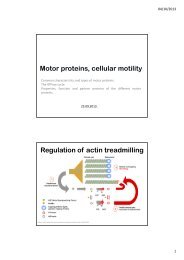
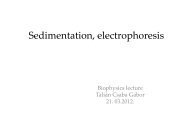
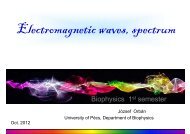
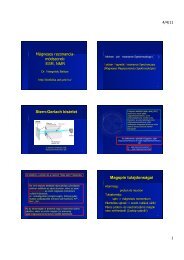
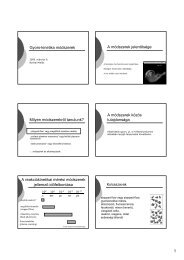
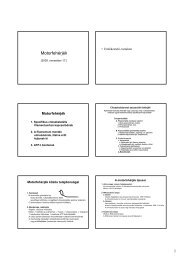

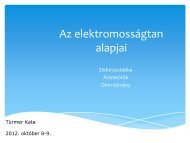
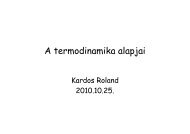
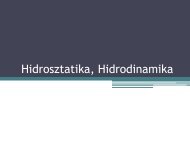

![Microsoft PowerPoint - Intermedier filamentumok [Kompatibilis m\363d]](https://img.yumpu.com/17119137/1/190x135/microsoft-powerpoint-intermedier-filamentumok-kompatibilis-m363d.jpg?quality=85)
